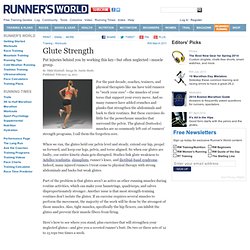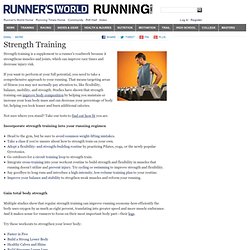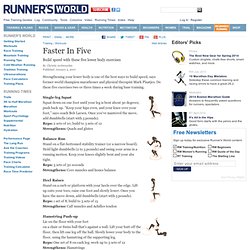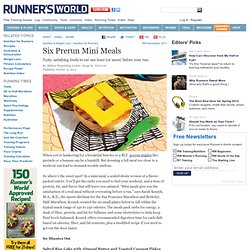

A new approach to strength training for runners. By Gary LavinPosted Tuesday, 20 December, 2005 First I realized to win my age group (or even place for that matter) I should have picked better parents since genetics is a big factor.

The second thing I realized is that if I have some free time I would rather be outside running. Third and most importantly, it amazes me that very few of the runners/endurance athletes I encounter ever step foot inside the gym. If they do go to the gym it is usually because of bad weather and they need to use the treadmill. When I ask runners why they do not lift, the answers are invariably the same.
Although it is true that a lot of training time needs to be dedicated to running, you must also take into consideration the efficiency of your running. The few “thrill seekers” that do enter the gym to strength train usually do so in a somewhat dysfunctional manner. Below are some old running myths. Old Running Myths In the world of running there is a lot of hoopla about VO2. Glute Strengthening Workout. For the past decade, coaches, trainers, and physical therapists like me have told runners to "work your core"—the muscles of your torso that support your every move.

And so many runners have added crunches and planks that strengthen the abdominals and back to their routines. But these exercises do little for the powerhouse muscles that surround the pelvis. The gluteal (buttocks) muscles are so commonly left out of runners' strength programs, I call them the forgotten core. When we run, the glutes hold our pelvis level and steady, extend our hip, propel us forward, and keep our legs, pelvis, and torso aligned. So when our glutes are faulty, our entire kinetic chain gets disrupted.
Part of the problem is that glutes aren't as active as other running muscles during routine activities, which can make your hamstrings, quadriceps, and calves disproportionately stronger. Seat CheckTest your glute strength SINGLE-LEG STANCE TESTStand with your hands over your head, palms together. 1. S#*! Strength Training. Strength training is a supplement to a runner's roadwork because it strengthens muscles and joints, which can improve race times and decrease injury risk.

If you want to perform at your full potential, you need to take a comprehensive approach to your running. That means targeting areas of fitness you may not normally pay attention to, like flexibility, balance, mobility, and strength. Studies have shown that strength training can improve body composition by helping you maintain or increase your lean body mass and can decrease your percentage of body fat, helping you look leaner and burn additional calories. Not sure where you stand? Take our tests to find out how fit you are. Faster In Five. Strengthening your lower body is one of the best ways to build speed, says former world champion marathoner and physical therapist Mark Plaatjes.

Do these five exercises two or three times a week during base training. Single-leg Squat Squat down on one foot until your leg is bent about 50 degrees; push back up. "Keep your hips even, and your knee over your foot," says coach Bob Larsen. Once you've mastered the move, add dumbbells (start with 5 pounds). Reps: 2 sets of 10; build to 3 sets of 12Strengthens: Quads and glutes Balance Run Stand on a flat-bottomed stability trainer (or a narrow board). Heel Raises Stand on a curb or platform with your heels over the edge. Hamstring Push-up Lie on the floor with your feet on a chair or Swiss ball that's against a wall. Plank + Lift From a push-up position, drop onto your forearms. The Four Best Strength Training Exercises For Runners - Page 2 of 5. Six Prerun Mini Meals. When you're hankering for a breakfast burrito or a BLT, prerun staples like pretzels or a banana can be a buzzkill.

But downing a full meal too close to a workout can lead to stomach trouble midrun. So where's the sweet spot? In a mini meal, a scaled-down version of a flavor-packed entrée. You'll get the carbs you need to fuel your workout, and a dose of protein, fat, and flavor that will leave you satiated. "Mini meals give you the satisfaction of a real meal without overeating before a run," says Sarah Koszyk, M.A., R.D., the sports dietitian for the San Francisco Marathon and Berkeley Half-Marathon. 60 Minutes Out Salted Rice Cake with Almond Butter and Toasted Coconut FlakesCalories: 160Rice cakes have a bad rap as a bland diet food, but that very quality makes them an excellent base for a light meal. 90 Minutes Out Open-Faced Smoked Turkey SandwichCalories: 170Koszyk views this streamlined lunch staple as a go-to choice for avoiding a midmorning prerun pastry or a midday cookie.